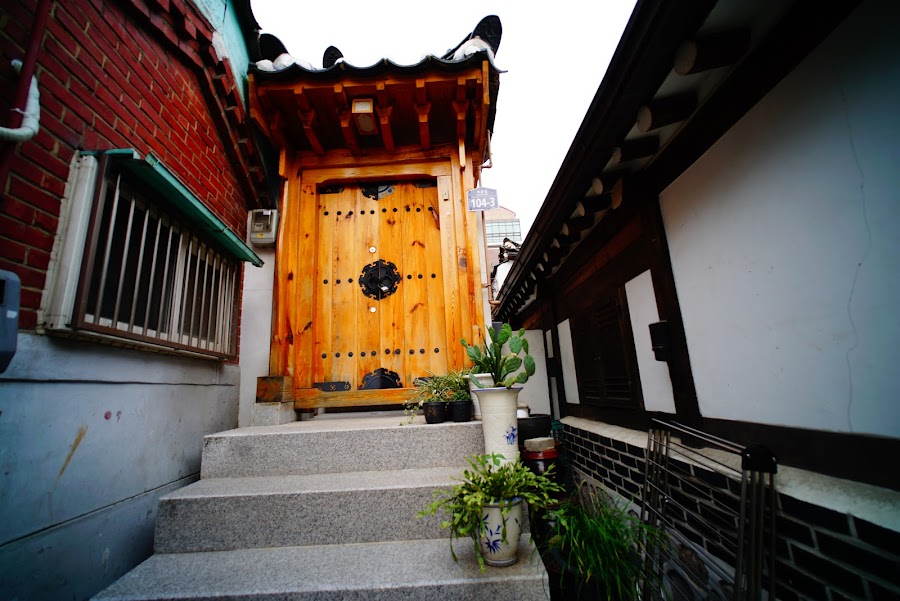
Spanish
Al pedir consejo acerca de Seúl a nuestro amigo Marco - el que más veces ha visitado la ciudad, me contestó "no sé, yo simplemente me quedo dando vueltas en Bukchon cuando voy..." viniendo de él, la única persona que conozco que esté tan enamorado de Asia y que hace tantas fotos como nosotros, me pregunté qué tendría Bukchon para gustarle tanto.
Localizado entre los dos palacios principales de Seoul, Gyeongbokgung y Changdeokgung, Bukchon es el barrio hanok más extenso de Seúl.
Los hanok「한옥」o residencias tradicionales Koreanas tienen una historia muy antigua, pero siguen siendo algo muy actual como patrimonio histórico y manera de preservar otro estilo de vida. Son estructuras muy ecológicas, por muchas razones:
- Materiales: Madera, piedra y papel encerado en las ventanas
- Forma: Varía según la latitud, en el norte tiene forma de letra Koreana "ㅁ" para bloquear la corriente; en el sur tiene forma de número uno 一, para facilitar la corriente de aire y en el centro, donde está Seúl, tiene forma de letras"L" or "ㄱ", como punto intermedio entre los dos anteriores
- Calefacción sostenible: El suelo radiante, llamado ondol「온돌」es un invento Koreano. Las casas se construían elevadas y la cocina en un cuarto separado, para manetener las habitaciones libres de humos y también facilitar que el aire caliente del fogón circulara bajo la casa, calentándola desde el suelo. Los cimientos se construían en piedra, que lleva tiempo calentar, pero se mantiene caliente durante mucho tiempo.
- Refrigeración sostenible Los laterales de las habitaciones son ventanas de madera que usan papel encerado en lugar de papel, de esta forma tenemos un muro muy ligero que se puede colocar en invierno y abrir casi completamente cuando aprieta la humedad y el calor del verano
- Estabilidad: Aunque en Korea haya menos terremotos que en Japón, siguen siendo una posibilidad, que afrontaban insertando las columnas entre las piedras en lugar del suelo, de manera que se agiten con la superficie y sobrevivan a los temblores.
Lo ideal es comenzar la visita en el Bukchon Cultural Center [WEB], hacerte con un mapa y explorar el área a tu ritmo! En 2010, las casas estaban más o menos aisladas y la zona estaba mucho menos preparada para el turimos. Aunque fuera un poco shock verlo todo tan desarrollado, elegir un paseo por Bukchon como ruta de camino a Changdeokgung tras la visita a Gyeongbokgung fue un gran acierto!
English
When asking our dear friend Marco, aka the one who has visited Seoul more than anyone else in my circle, he answered: "I don't know, just spend all my time in Bukchon when I'm there...". Located between the two main Palaces of Seoul, Gyeongbokgung and Changdeokgung, Bukchon is the largest hanok area in Seoul.
Hanok「한옥」are traditional Korean houses, which originated way back in the past but are still maintained today as cultural heritage. They are environment-friendly in terms of:
- Ecologic materials: Wood, stone, waxed paper on the windows
- Layout: shaped like Korean letter "ㅁ" in the North to block the wind flow; shaped like number 一 in the south, for the wind to flow; shaped like Korean letters "L" or "ㄱ", in the center for a balance between the 2 previous styles)
- Sustainable heating: Called ondol「온돌」 where the hot air from the kitchen fire would circulate under the entire home warming it from the floor
- Sustainable cooling: Using wax paper covered windows which were kept closed in winter, but widely open in summer.
- Earthquake prevention: Solving the problem smartly, by insertion of the wooden posts into cornerstones instead of the ground, to keep them stable during earth movements.
The best is to start at the Bukchon Cultural Center [WEB], grab a map and get lost in these streets! I was quite shocked to see the development of this area that I had not walked thoroughly since my first visit in 2010 and it turned out to be a great choice to check out on the way Changdeokgung, after the Gyeongbokgung visit.
 Old style café
Old style café  Impressive wooden doors and low rise houses everywhere
Impressive wooden doors and low rise houses everywhere  Cool businesses that blend old Korean traditions with a contemporary touch.
Cool businesses that blend old Korean traditions with a contemporary touch.  Affordable (8€ each) cool fashion everywhere.
Affordable (8€ each) cool fashion everywhere.  Houses with stone statues at the entrance, just like the ones we had seen at the Korean Folk Village moments before.
Houses with stone statues at the entrance, just like the ones we had seen at the Korean Folk Village moments before. 





















No comments
Post a Comment